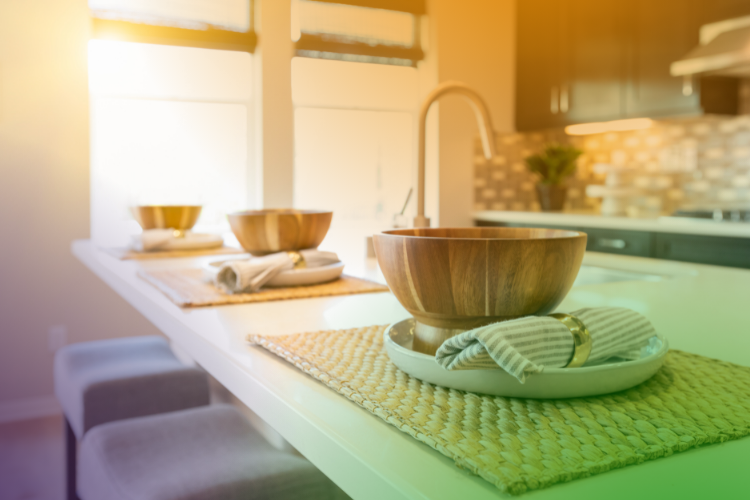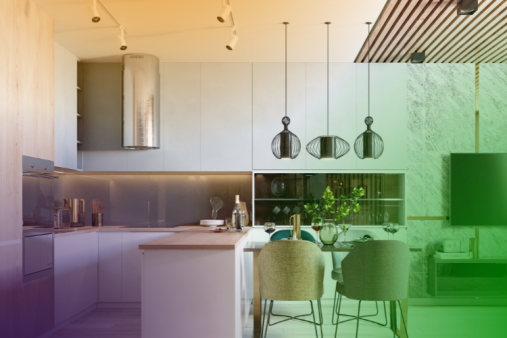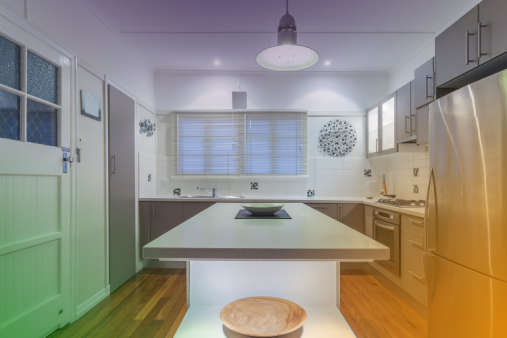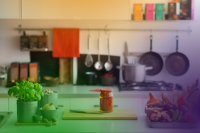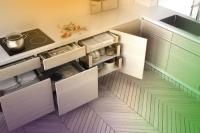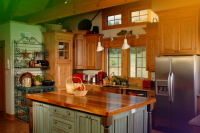Kitchen islands are often top of homeowner’s design wish lists. They don’t just look amazing, but also provide a great focal point for any kitchen. Getting the right kitchen island for your space isn’t always straightforward though, and there are many factors which should be taken into consideration when evaluating all the different colours, shapes, and styles of island on the market. There’s no shortage of inspiration in the pages of the glossy interior design magazines, on lifestyle blogs, and on the web pages of interiors bloggers, and retail stores selling kitchen cabinets, appliances and accessories.
Do I Have Space for a Kitchen Island?
Most kitchen designers agree that the minimum size for an effective kitchen island is four feet long by two wide. If you have a very small kitchen, or a galley-style kitchen, then you might not be able to squeeze one in. In tems of the maximum size, as long as there is enough space for people to move around the island and use the kitchen effectively, anything goes. Most islands in kitchens are square or rectangular, but they don’t have to be. Look online at some innovative kitchen designs with oval shaped islands, or shapes incorporating a dining space at one end. The design is really only limited by the worksurface you will be using, and the space available.
If you are thinking of having people sitting at your kitchen island to eat, the general rule of thumb is that each person will need two feet – around 60cm – of space to sit and eat in comfort. You will also need the worksurface to overhang any cabinets or appliances by at least 23cm, preferably more, to leave space for knees and legs.
Consider the Uses of your Kitchen Island
Most kitchen islands have a similar format, incorporating cabinets or cupboards on the side of /side of the island usually has some sort of seating, on high seats or stools. Depending on your kitchen design, you may choose to incorporate a hob on your kitchen island, or perhaps a sink. Underneath your kitchen island’s worksurface, you might choose to have cupboards or shelves, or to hide away appliances such as washing machine or dishwasher. Any decent kitchen designer will be able to talk you through your options, and most showrooms will have software which lets you play around with different layouts to work out which arrangement of appliances and cabinets would work best for you and your family. Think about lighting too; a pendant light over an island is a popular choice and will also help separate up the space.
Kitchen islands are ideal for splitting up the space between cooking and living in an open-plan layout. They provide casual dining space for occasions when you might not want to sit at the table, or a give a place for the kids to do their homework while you get on with cooking.
Portable Kitchen Islands
If you have a smaller than average kitchen, or have an awkwardly-shaped kitchen which makes fitting in an island difficult, then the best option for you could be a portable kitchen island. These aren’t as large as a conventional fitted island, but can be stored in another room or in the corner of the kitchen, and wheeled out when you need an extra surface for food prep. These come in all shapes and sizes from a size butcher’s block style unit, to a much bigger piece of furniture. Even for larger kitchens, having a kitchen island which can be moved around increases the flexibility of how you use your kitchen. If you can’t find the perfect shape and size of unit despite the large range of choices on the market, think about contacting a local carpenter or joiner to have something custom-made to your requirements. Bespoke doesn’t have to mean ridiculously pricy, and you’re guaranteed to get the perfect item for your home.
Best Style for a Kitchen Island
Kitchen design choices are very personal. Unless you are upgrading your kitchen purely with a view to selling your home and maximising its value, then it’s probably not that important what other people think about your design preferences. Its standard practice to match your kitchen island design into the rest of the design in the kitchen, by choosing the same design of cabinets and worksurfaces as you are using elsewhere in the kitchen. But there’s always the option to do something a bit different, whether that be using a different worksurface on the island, or perhaps using darker or lighter cabinets. A new kitchen represents a significant investment for most people though, and it’s worth taking some time over your selection. Try to avoid any high-fashion kitchen choices, which might look fabulous for a year or two, then date quickly. Stick to a classic, simple choice for your cabinets and worktops, but let your fashion sense run wild on things which are easier to replace, such as taps, blinds or paint colours.
Surfaces for Kitchen Islands
The worksurface you choose for your kitchen island will depend in a large part on how you intend to use it. If, for example, you are planning on having a sink and draining board on your kitchen island, the surface you choose should be water resistant. A hob on an island might mean food or oil splatters on your island surface, so take care to choose a surface which is easily cleaned or simple to maintain. Natural wood looks great but can be tricky to look after and will require sealing and gentle cleaning rather than harsh chemicals. Granite is classy and very hardwearing but can be very expensive, especially over larger areas. Laminate and composite are good mid-range budget choices, and have the benefit of coming in a wide range of colours and finishes. Don’t rush into any decisions; take your time and look at lots of samples before making your final choice. Remember also to match your worksurface choice with the cabinets. Most kitchen showrooms will provide small samples to make this easier.
